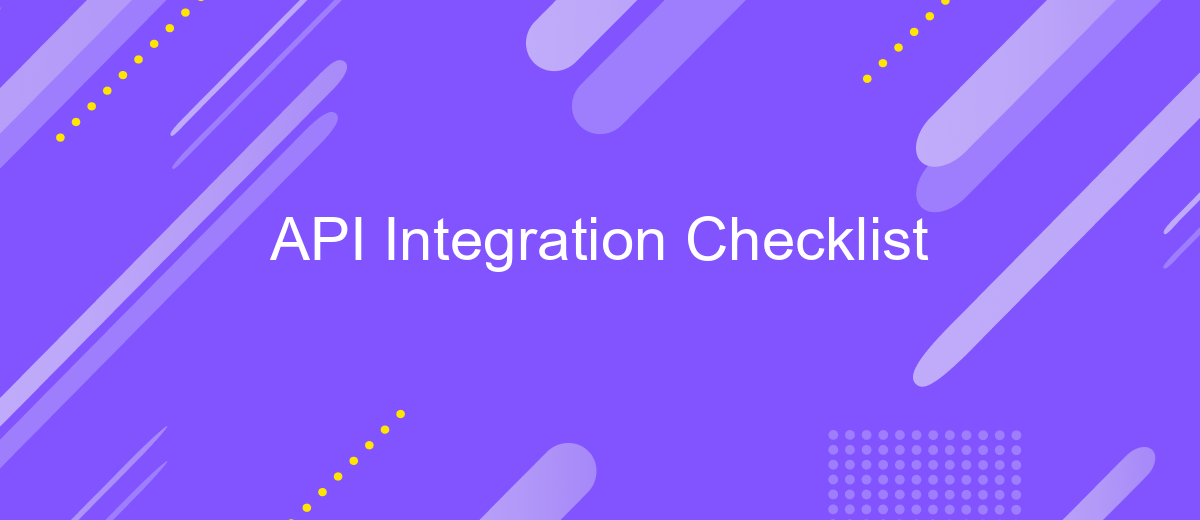API Integration Checklist
In today's digital landscape, seamless API integration is crucial for enhancing functionality and ensuring smooth communication between systems. Whether you're a developer or a project manager, having a comprehensive checklist can streamline the integration process and minimize potential issues. This article provides a step-by-step API Integration Checklist to guide you through planning, implementation, and testing, ensuring a robust and efficient integration experience for your projects.
API Documentation and Understanding
Understanding API documentation is crucial for successful integration. It provides comprehensive details on how to interact with the API, including endpoints, request methods, and expected responses. Thoroughly reviewing the documentation helps prevent errors and ensures that the integration process is smooth and efficient.
- Read through the API overview to grasp its capabilities and limitations.
- Familiarize yourself with authentication requirements and security protocols.
- Examine endpoint details, including URLs, request types, and parameters.
- Review sample requests and responses to understand expected data formats.
- Check for any rate limits or usage restrictions that may impact your application.
By carefully studying the API documentation, developers can gain a clear understanding of how to effectively leverage the API's features. This knowledge not only aids in efficient coding practices but also contributes to a more seamless user experience. Additionally, having a solid grasp of the API's functionality enables developers to troubleshoot issues more effectively and make informed decisions during the integration process.
Authentication and Authorization

Ensuring secure API integration begins with robust authentication and authorization mechanisms. Authentication verifies the identity of users or systems, typically using methods such as API keys, OAuth tokens, or JWTs. It's crucial to choose an authentication method that aligns with your system's security requirements and user experience. For instance, OAuth 2.0 is favored for its ability to provide secure delegated access, making it ideal for applications that require third-party access to user data without exposing credentials. Additionally, ensure that the tokens or keys are stored securely and rotated regularly to prevent unauthorized access.
Authorization, on the other hand, determines what resources or actions an authenticated user or system can access. Implement role-based access control (RBAC) to define permissions based on roles, ensuring that users have access only to the resources necessary for their role. Tools like ApiX-Drive can streamline the integration process, offering pre-built connectors and automation capabilities that simplify managing authentication and authorization across various platforms. Regularly audit and update access permissions to maintain security and compliance with industry standards. By prioritizing these practices, you can significantly enhance the security of your API integrations.
Data Mapping and Transformation

Data mapping and transformation are critical components of API integration, ensuring that data is accurately transferred between systems. This process involves aligning data fields from one system to another, which may require conversion or modification to maintain data integrity and usability. Proper data mapping and transformation prevent data discrepancies and ensure seamless communication between integrated systems.
- Identify data fields: Determine which data fields need to be mapped between the source and target systems.
- Define transformation rules: Establish rules for converting data formats, units, or structures to ensure compatibility.
- Test mapping accuracy: Conduct tests to verify that data is correctly mapped and transformed, identifying any errors or inconsistencies.
- Document the mapping process: Keep detailed records of mapping and transformation rules for future reference and troubleshooting.
Effective data mapping and transformation require careful planning and execution. By following a structured approach, organizations can minimize errors and ensure that data flows smoothly across integrated systems. This leads to improved data accuracy, operational efficiency, and the ability to make informed decisions based on reliable data insights.
Error Handling and Logging

Error handling and logging are critical aspects of API integration, ensuring that your application can gracefully handle unexpected issues and provide valuable insights for troubleshooting. Proper error management helps maintain a seamless user experience and aids developers in identifying and resolving issues quickly.
When integrating APIs, it's essential to anticipate potential errors and implement robust handling mechanisms. This involves categorizing errors, defining appropriate responses, and ensuring that error messages are clear and informative. Logging, on the other hand, provides a record of events and errors, which is invaluable for debugging and monitoring the health of your integration.
- Implement standardized error codes and messages to ensure consistency.
- Use try-catch blocks to handle exceptions gracefully.
- Log all API requests and responses for audit and debugging purposes.
- Ensure logs are stored securely and comply with data protection regulations.
By prioritizing error handling and logging, you not only enhance the reliability and performance of your API integration but also empower your development team to respond swiftly to any issues that arise. This proactive approach minimizes downtime and fosters a more resilient application ecosystem.
- Automate the work of an online store or landing
- Empower through integration
- Don't spend money on programmers and integrators
- Save time by automating routine tasks
Testing and Validation
Testing and validation are crucial steps in ensuring the reliability and functionality of API integrations. Begin by developing comprehensive test cases that cover all possible scenarios, including edge cases and error handling. Automated testing tools can be invaluable here, allowing you to simulate API calls and verify responses quickly and accurately. It's important to test both the API's performance under expected load and its behavior under stress conditions to ensure it can handle real-world usage.
Once testing is complete, validation ensures that the integration meets all specified requirements and functions as intended. This involves cross-checking the API's outputs with expected results and confirming that data is correctly transferred and processed between systems. Services like ApiX-Drive can simplify this process by providing a user-friendly platform for setting up and managing integrations, reducing the potential for errors. Continuous monitoring post-deployment is also recommended to promptly identify and resolve any issues that may arise, ensuring a seamless and efficient integration experience.
FAQ
What is an API integration checklist?
Why is authentication important in API integration?
How can I test an API integration effectively?
What should I consider regarding data formats in API integration?
How can I monitor the performance of an API integration?
Time is the most valuable resource in today's business realities. By eliminating the routine from work processes, you will get more opportunities to implement the most daring plans and ideas. Choose – you can continue to waste time, money and nerves on inefficient solutions, or you can use ApiX-Drive, automating work processes and achieving results with minimal investment of money, effort and human resources.


